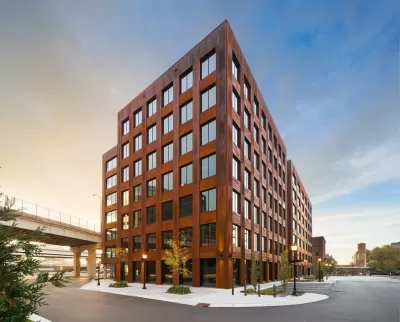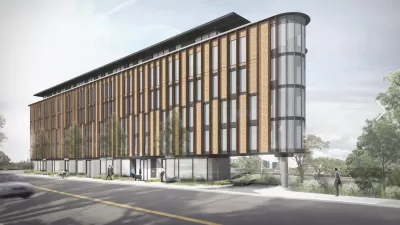A move toward wooden buildings would lead to a host of positive environmental, economic, and livability outcomes.

"Forest ecosystems and wood buildings can be our most important climate allies," argue Frank Lowenstein, Brian Donahue, and David Foster in a New York Times opinion piece. While concrete and steel are ubiquitous construction materials, they are not sustainable.
Using sustainably harvested wood for buildings, however, offers a range of benefits, they say. "This will allow us to pump carbon from the atmosphere and store it both in forests and in cities. It will also support rural economies, improve wildlife habitat and create more affordable housing."
Engineered wood available as cross-laminated timber is what is allowing for taller, fire-safe wooden buildings. "We should minimize the conversion of forests, enable more wood construction and incentivize private landowners to improve their stewardship," urge Lowenstein, Donahue, and Foster.
FULL STORY: Let’s Fill Our Cities With Taller, Wooden Buildings

Alabama: Trump Terminates Settlements for Black Communities Harmed By Raw Sewage
Trump deemed the landmark civil rights agreement “illegal DEI and environmental justice policy.”

Planetizen Federal Action Tracker
A weekly monitor of how Trump’s orders and actions are impacting planners and planning in America.

The 120 Year Old Tiny Home Villages That Sheltered San Francisco’s Earthquake Refugees
More than a century ago, San Francisco mobilized to house thousands of residents displaced by the 1906 earthquake. Could their strategy offer a model for the present?

In Both Crashes and Crime, Public Transportation is Far Safer than Driving
Contrary to popular assumptions, public transportation has far lower crash and crime rates than automobile travel. For safer communities, improve and encourage transit travel.

Report: Zoning Reforms Should Complement Nashville’s Ambitious Transit Plan
Without reform, restrictive zoning codes will limit the impact of the city’s planned transit expansion and could exclude some of the residents who depend on transit the most.

Judge Orders Release of Frozen IRA, IIJA Funding
The decision is a victory for environmental groups who charged that freezing funds for critical infrastructure and disaster response programs caused “real and irreparable harm” to communities.
Urban Design for Planners 1: Software Tools
This six-course series explores essential urban design concepts using open source software and equips planners with the tools they need to participate fully in the urban design process.
Planning for Universal Design
Learn the tools for implementing Universal Design in planning regulations.
Clanton & Associates, Inc.
Jessamine County Fiscal Court
Institute for Housing and Urban Development Studies (IHS)
City of Grandview
Harvard GSD Executive Education
Toledo-Lucas County Plan Commissions
Salt Lake City
NYU Wagner Graduate School of Public Service





























